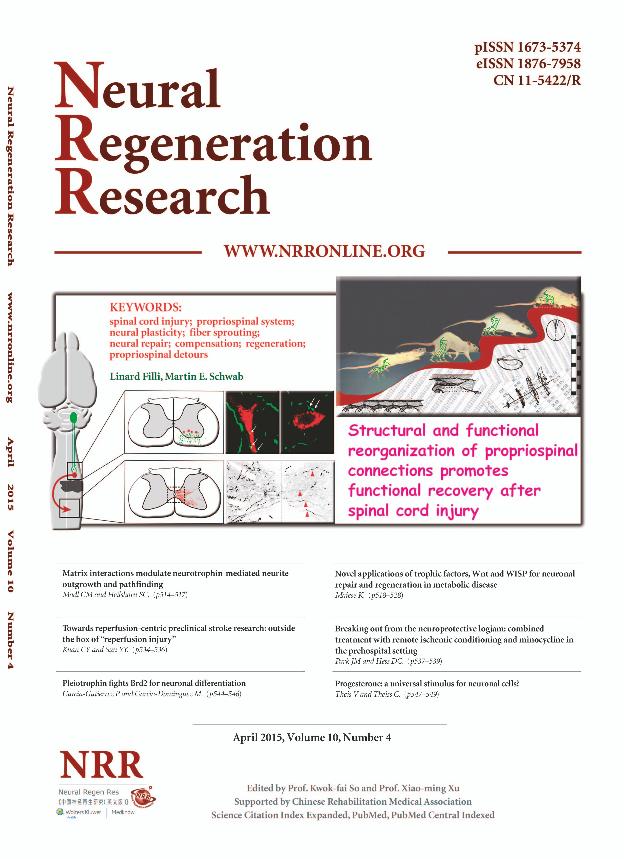Mostrar el registro sencillo del ítem
dc.contributor.author
Caltana, Laura Romina

dc.contributor.author
Nieto, Maria Luisa
dc.contributor.author
Brusco, Herminia Alicia

dc.date.available
2020-04-15T20:58:22Z
dc.date.issued
2015-04
dc.identifier.citation
Caltana, Laura Romina; Nieto, Maria Luisa; Brusco, Herminia Alicia; Oleanolic acid: a promising neuroprotective agent for cerebral ischemia; Shenyang Editorial Dept Neural Regeneration Res; Neural Regeneration Research; 10; 4; 4-2015; 540-541
dc.identifier.issn
1673-5374
dc.identifier.uri
http://hdl.handle.net/11336/102697
dc.description.abstract
Stroke is considered the most common and severely disabling neurologicaldisease. It is one of the leading causes of death after heartdisease and cancer, causing 10% deaths worldwide and involvingrisk factors such as smoking, obesity and nutritional disbalance.Disability affects 75% of stroke survivors through severe mentaland/or physical impairment depending on the affected brain area(Go et al., 2014).Stroke treatment is limited to thrombolysis and antiplatelettherapy with a tissue plasminogen activator (tPA), which is onlyuseful if administered within 3 hours of the appearance of earlysymptoms. This therapy is only used in 1?2% stroke patients andhas, indeed, limited clinical success, as it does not protect neuronsfrom the hypoxic insult. Therefore, the development and evaluationof new drugs to reduce the life-threatening effects of strokeand hypoxia might prove extremely fruitful.Stroke is produced by a decrease in blood supply due to differenttypes of alterations in the brain blood vessels, which cause cerebralhypoxia/ischemia. In turn, the hypoxic damage produces severalchanges in gene expression patterns in brain tissue cells (neuronsand glial cells). Rapid thrombolysis is effective in protecting theinjured ischemic core, although preventing the pathological featuresthat produce neuronal death requires the development of newtreatments and the implementation of a dual therapy combiningthe disruption of the clot and the preservation of neuronal function.In this respect, many preclinical studies have been successfulin finding neuroprotective agents, but subsequent clinical trialshave rendered disappointing results.Inflammation is one of the distinctive events in stroke, whilemicroglial cells are the predominant inflammatory effectors inbrain. Reactive astrocytosis and the formation of a glial scar in theboundary zone of the ischemic core are also critical events whichcan produce both positive and negative consequences.
dc.format
application/pdf
dc.language.iso
eng
dc.publisher
Shenyang Editorial Dept Neural Regeneration Res

dc.rights
info:eu-repo/semantics/openAccess
dc.rights.uri
https://creativecommons.org/licenses/by-nc-sa/2.5/ar/
dc.subject
OLEANOIC ACID
dc.subject
NEUROPROTECTION
dc.subject.classification
Otras Medicina Básica

dc.subject.classification
Medicina Básica

dc.subject.classification
CIENCIAS MÉDICAS Y DE LA SALUD

dc.title
Oleanolic acid: a promising neuroprotective agent for cerebral ischemia
dc.type
info:eu-repo/semantics/article
dc.type
info:ar-repo/semantics/artículo
dc.type
info:eu-repo/semantics/publishedVersion
dc.date.updated
2020-01-10T14:56:39Z
dc.journal.volume
10
dc.journal.number
4
dc.journal.pagination
540-541
dc.journal.pais
China

dc.description.fil
Fil: Caltana, Laura Romina. Consejo Nacional de Investigaciones Científicas y Técnicas. Oficina de Coordinación Administrativa Houssay. Instituto de Biología Celular y Neurociencia "Prof. Eduardo de Robertis". Universidad de Buenos Aires. Facultad de Medicina. Instituto de Biología Celular y Neurociencia; Argentina
dc.description.fil
Fil: Nieto, Maria Luisa. Consejo Superior de Investigaciones Científicas; España
dc.description.fil
Fil: Brusco, Herminia Alicia. Consejo Nacional de Investigaciones Científicas y Técnicas. Oficina de Coordinación Administrativa Houssay. Instituto de Biología Celular y Neurociencia "Prof. Eduardo de Robertis". Universidad de Buenos Aires. Facultad de Medicina. Instituto de Biología Celular y Neurociencia; Argentina
dc.journal.title
Neural Regeneration Research

dc.relation.alternativeid
info:eu-repo/semantics/altIdentifier/doi/http://dx.doi.org/10.4103/1673-5374.155414
dc.relation.alternativeid
info:eu-repo/semantics/altIdentifier/url/https://www.ncbi.nlm.nih.gov/pmc/articles/PMC4424737/
dc.relation.alternativeid
info:eu-repo/semantics/altIdentifier/url/http://www.nrronline.org/article.asp?issn=1673-5374;year=2015;volume=10;issue=4;spage=540;epage=541;aulast=Laura
Archivos asociados
